This was published 9 years ago
The safe room
In some European cities, drug dealers and addicts are watched over by the police at legal consumption rooms. Could Australia's ice epidemic be contained if we did the same?
By by Eamonn Duff
As mid-afternoon shadows creep across Bern's cobblestone streets, the drug dealers emerge from laneways and parks with multiple hits of heroin and cocaine stashed deep inside their pockets. As they file down a narrow footpath towards their destination, two plain-clothes senior police officers watch from an elevated window in their station, which is strategically located across the street.
One by one, the sellers, who are addicts themselves, stop at a gate flanked by two burly bouncers. After slotting identity cards into an electronic scanner, they are ushered into a small, open, stone-paved courtyard where, in a remarkable daily ritual, they trade among themselves. If those in the courtyard are unfazed by the fact that detectives are watching their every move from above, it is with good reason: the Swiss city's law enforcement agency created this drug hub especially for them. Several hundred metres from the clock tower that helped Albert Einstein rewrite the rules of physics with his theory of relativity, modern-day pioneers are reinventing how the world addresses the many problems associated with drug addiction.
Switzerland's capital has responded to the challenges of drug abuse with unprecedented solutions. When Bern was awash with heroin and overdose-related deaths three decades ago, it developed a protected space – a world first – where opiate-dependent citizens could safely consume drugs and be steered into treatment. More recently, the same centre introduced its police-approved "courtyard system" so that registered clients can discreetly buy and sell among themselves, well away from the shops and streets so popular with tourists.
With Australia struggling to curb its crisis with methamphetamine, or ice, two of our nation's leading drug reform campaigners, Dr Alex Wodak and Matt Noffs, have embarked on a research mission to Europe where Switzerland and Germany have started a harm reduction revolution. Between them, these two countries account for more than a third of the 90 officially sanctioned drug consumption rooms worldwide. Drug consumption patterns among the 60 or so cities that have introduced the rooms differ, but the rooms all serve the same purpose, which is to provide a safe environment where users can inject or inhale their drug of choice under the supervision of trained staff. It is also hoped that the rooms reduce drug-related deaths, injuries and disease while increasing referral rates to treatment and support services.
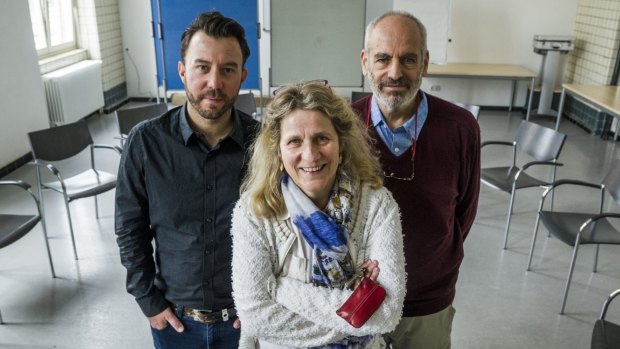
Dr Alex Wodak, right, and Matt Noffs, pictured here with The Schielestrasse centre's Gabi Becker, have embarked on a research mission to Europe where Switzerland and Germany have started a harm reduction revolution.Credit: Bert Bostelmann
In Switzerland, there are rooms across eight cities tackling problems triggered predominantly by heroin and crack cocaine. Germany faces similar problems with heroin, but ice is also seeping in from the Czech Republic, where it is widely abused. The consumption room in Oslo, Norway, is at the frontline of a major, national battle against ice. Is Australia ready to adopt the European model?
As head of the Noffs Foundation, which runs adolescent drug treatment programs, Matt Noffs has witnessed firsthand the havoc and heartbreak caused by methamphetamine use. In his new book Breaking the Ice, Noffs controversially lays the blame squarely at the feet of our politicians who, he says, persist with the same "failed" strategy of treating drug use as a crime, as opposed to a public health issue. Wodak, the former director of the Alcohol and Drug Service at Sydney's St Vincent's Hospital, agrees. "In every other field, we look at the world's best practice and at least try and catch up. But when it comes to drugs and harm minimisation, we are incredibly isolated and insular."
If the fundamental aim of drug consumption facilities is to save lives, then research shows they are working. Two years ago, a European Commission-funded report referred to both the rooms and the reduction in related overdose deaths as a "milestone" in the development of drug services. And, in a summary of 134 papers and reports published on the services worldwide, Australia's Drug Policy Modelling Program listed a host of "positive outcomes" including a reduction in crime and greater access to health and welfare services.
Having witnessed these rooms in Europe, Wodak and Noffs intend to establish an Australian model tailored for "inhalation", which is how the majority of users consume ice. Wodak points out that some of Australia's most prominent political and police figures have started to acknowledge that, as former Australian Federal Police commissioner Mick Palmer puts it, "we cannot arrest and imprison our way" out of problems regarding illicit drugs.
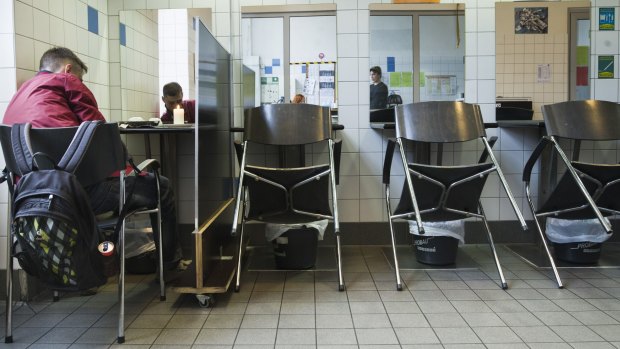
Frankfurt's largest drug consumption room has just installed a purpose-built inhalation room as part of a multimillion-euro refit.Credit: Bert Bostelmann
"Despite best efforts and strong intent, we have achieved virtually nothing," says Palmer. "We've aggravated harm rather than minimised it. We've demonised users; not provided the support we should. The reality is, people are going to take ice. It's time to take the risk and trial new options because, as evidence demonstrates elsewhere, it's working."
Wodak says Europe's responses to managing drug addiction "are wins for communities, for police, for the people who use drugs and the clinicians who look after them". But when we meet in Switzerland, I ask Wodak whether most Australians might see a network of drug centres, facilitating ice use, as a bit too radical. "It isn't radical," says Wodak. "Radical is sticking with something that you clearly know does not work."
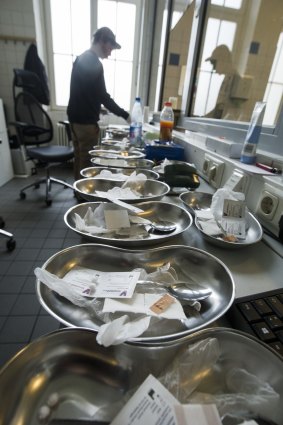
Staff preparing tools for drug consumption for clients.Credit: Bert Bostelmann
Wodak and Dr Robert Haemmig, a Swiss psychiatrist, have much in common. While both are too humble to say it, their achievements have changed the world. In 1986, in an act of civil disobedience, Haemmig pioneered the world's first legally sanctioned drug consumption centre in Bern.
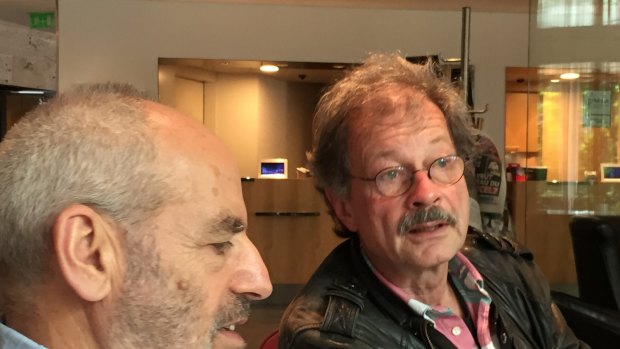
Dr Robert Haemmig and Dr Alex WodakCredit: Eamonn Duff
Wodak and his colleagues in Sydney's Kings Cross overcame a wave of political hostility, leading to the establishment of the first medically supervised injecting centre in the English-speaking world in 2001. Though 15 years apart, both facilities represented highly contentious responses to catastrophes involving heroin. As Haemmig accompanies us through the streets of Bern towards the centre where it all started, he describes the tragic scene of the mid-'80s. "Junkies were everywhere here," he recalls. "AIDS and overdoses were a big problem. People were dying like flies."
In response to that crisis, he created "somewhere for drug users to go", a cafe-style shelter of the type which, ordinarily, they would be barred from. There were complimentary meals, clean needles, free condoms and a team of compassionate social workers and counsellors. It was never originally his intention to provide a space where users would take drugs, but it was not long after opening that two men came in, sat down, produced syringes and injected. Haemmig remembers a social worker turning to him and gasping in shock. A moment of indecision followed. "Before we had made a move, they'd already stood up and left," he says.
Suddenly, Bern's heroin-dependent community had a welcoming alternative to the regular nooks and crannies. But as the trend escalated, so – inevitably – did tensions with police. "They demanded the room be shut, they threatened to arrest me … all sorts of things," says Haemmig, who in turn erected a small drug consumption "tent" in a public park that was plagued by open drug use and public-order problems. It was located right outside parliament. "We stayed for one week," he says with only a hint of a smile. Through subsequent negotiations with police and lawmakers, the cafe shelter was given legal approval on the condition that users were over 18 and seeking suitable medical supervision for their addiction. "That was the start of injecting rooms," he says.
While little research was conducted during the centre's earlier years, its impact was evident in three client surveys in 1990, 1995 and 2001, which charted significant declines in risky behaviour, particularly the practice of sharing used needles.
Haemmig has gradually stepped back from the day-to-day running of the service, which has moved to a larger site where specialist doctors, nurses and counsellors form a team of around 70. Nowadays, it's a place where Bern's most marginalised can access showers, washing machines and a change of clothes donated by local retailers. The actual injecting room, where clients sit, prepare and administer their drugs, is a simple, sterile environment with stainless steel surfaces. Fresh spoons, needles and syringes are laid out alongside other essentials such as tissues and cotton pads.
When, 12 years ago, it became evident that drug trends in Bern were shifting towards crack cocaine and addicts were migrating from injecting to inhaling, the centre introduced a fully enclosed inhalation room. This purpose-built facility enables clients to inhale the drug using crack pipes or, in the case of heroin, "chase the dragon" with aluminium foil and a straw. A powerful extractor fan sucks vapours outside the building via an elaborate duct system.
"There were so many young people on the streets who were inhaling but they could not legally come in because they weren't injecting," explains the centre's team leader, Bubi Rufener. When Bern's politicians initially blocked the installation, the police stepped in, Rufener says. "They said, 'Yes, if an inhalation room was open, we would have less people on the street, which in turn would be a win for the local restaurants and everybody else who runs a business.' "
When Wodak and Noffs tour the adjacent courtyard where buying and selling legally takes place, they are taken aback by the fact that police can peer in on everything from the windows across the street. Incredibly, even the angle of the yard's roof was designed so the view would not be obstructed. Rufener stresses that, whether buying or selling, the people who avail themselves of this unique system are predominantly homeless and comprise many of the city's most socially isolated citizens. "The police, the people of this town, we all share the same problems, so you have to find a way," he says. "This is not the solution. But it is part of the solution."
In much the same way that Henry Ford could never have envisaged what the modern-day motor car would look like, Haemmig could never possibly have foreseen what his own creation would inspire.
"Does it make you proud?" I ask him.
"It was an important impulse," he says. "A lot of places followed our model. Frankfurt, in particular, was very important."
In 1992, Frankfurt was on its knees. More than a thousand homeless heroin addicts were living in its central park. The business district had descended into an open drug scene. Junkies slumped in doorways and used needles littered the streets as AIDS and hepatitis spread through the injecting community. When the neighbouring banking sector began to twitch, Frankfurt had no choice but to call an emergency round table. Senior police, prosecutors and politicians joined stakeholders spanning the entire community. As part of that summit, an expert panel ventured to Switzerland, where they met Haemmig and toured his centre in Bern. There, the penny dropped. As Frederic Pietsch, who heads a specially trained police unit that targets drug dealing in central Frankfurt, tells Good Weekend: "The situation, for us, had become too hard to handle … traditional policing was not enough."
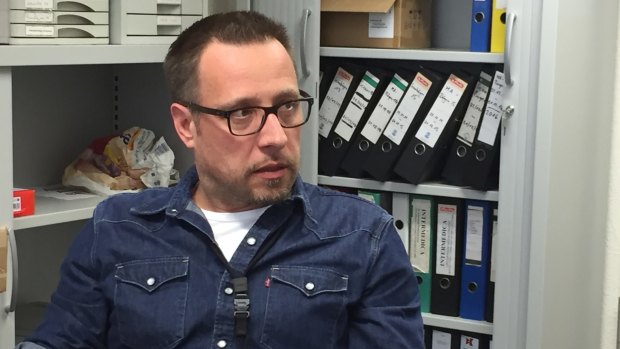
Frederic Pietsch, a Frankfurt police officer.Credit: Eamonn Duff
During our visit to Frankfurt, Pietsch explains how, in the beginning, there were "natural" challenges. "The police way of thinking was not the same as the health institutions. But we came together – bridges were built."
In 1994, the city of Frankfurt released three industrial heritage buildings providing almost 4000 square metres of space. From this impressive location at Schielestrasse, Germany's first official safe injecting room was launched. Later, in 2000, the German parliament tweaked its narcotics act to pave a clearer legal path for further facilities. Today, there are 26 drug consumption rooms in Germany, including three more in Frankfurt, four in Hamburg and three in Berlin. "Police physically removed all the people from the park and brought them here to this centre," recalls Gabi Becker, whose role is to source and manage the €6 million ($9 million) required annually to operate the Frankfurt services.
The Schielestrasse centre boasts overnight beds for between 80 and 100 drug users. There's a seminar space for those who want to reduce or stop their consumption. But most impressive is the training and work development opportunities that help clients to reintegrate socially. Take, for example, the on-site workshop where users learn carpentry and then run a service that restores and replaces Frankfurt's ageing park benches. Or the in-house laundry service that has dozens of clients across the city, including Frankfurt's own police headquarters, which gets its uniforms washed every Wednesday.
"We have work placements where up to 80 people a day are out there doing something," says Becker. "The clients must give back. It's no good just coming here to take drugs safely. If we are creating and offering a whole bundle of possibilities for these people to change their lives, they have to take them."
"But who funds this centre and all those opportunities?" asks Noffs.
"It comes from a variety of places but 95 per cent is covered by the city of Frankfurt," replies Becker. "It is written into our law. Each German city has a legal duty to help the homeless."
There's a silence as the travelling party digests all this. "I feel ashamed," says Wodak as he thinks of the Australian response. Amid a rising epidemic of crack cocaine – which, like ice, is mostly smoked – the centre took the "logical" next step in 2007 and introduced an inhalation room. "We just did it," says Becker, adding that since its installation, the centre has also been making a concerted effort to try and persuade heroin users to switch from injecting to inhaling.
"And are people switching?" asks Wodak.
"A few," she replies. "It's hard work, but we feel it would be worse not to try."
Across town at Niddastrasse, Frankfurt's largest drug consumption room has just installed a purpose-built inhalation room as part of a multimillion-euro refit. Purchased in 1997, the six-storey property is located in the neighbourhood around Frankfurt's central railway station, where the majority of the city's homeless drug users reside. Aside from two floors offering drug consumption facilities, there are social workers and specialist counselling for women. There are also three additional storeys of newly refurbished apartments leased by refugees and homeless people who don't have drug issues. The rental income, for which German welfare agencies have budgeted well into the future, is funnelled straight back into the running costs of the consumption rooms.
Its manager, Andreas Geremia, stresses to Good Weekend the importance of locating the centre close to its clients. "They opened a room in Cologne," he says. "They spent a lot of money. But it was 20 minutes to get to by train and only two people turned up each day. It is now closed. That was a big lesson."
His facility recorded more than 90,000 visits last year. One regular user is Kai, a homeless 45-year-old from Frankfurt who has been heroin-dependent since the late '90s. I ask him why he chooses to shoot up in the consumption room daily.
"It's a calm, quiet space," he replies. "There's a risk with hepatitis and AIDS on the streets but here you always have access to fresh needles. They teach you a cleaner way to fix. The crew [staff] know me here, they check on me and have helped me no end. They have corrected me [saved my life] seven or eight times after I overdosed."
Heiko, 42, who has been using heroin for two decades, says: "When you live out there, day in, day out, you're just another unwanted junkie running around between the cafes and tourists. This place is a break from all that. It's safe. I can come in, sit and rest here for maybe two, three, four hours. I cannot tell you how much that means."
Unlike the Bern model, where drug dealing is controlled on site, there is strictly no buying, selling or sharing within Frankfurt's facilities, with users only permitted to bring in "one consumption unit". But Kai and Heiko are two of 5500 people who are registered with police as "drug-dependent users", effectively meaning they have a get-out clause if they're picked up on the street with small amounts of drugs.
As the police force's Frederic Pietsch points out, the system is not without its challenges. "Under German law, buying, possessing and selling drugs is illegal. But consuming is not. So it's a very thin line we have to walk."
Fifteen years after it was regarded as a no-go zone, the city's main station area has been gentrified, with new hotels, restaurants and shops springing up weekly. But Pietsch admits that "not everybody is happy". "Those who lived here before tolerated the users but now, it's new people," he says. "They want to make money and they want their streets clean. When the users are in the consumption room, it's not a problem. But what do we do with them the rest of the time?"
Before Frankfurt opened its first drug consumption room, drug overdose deaths in the city had spiked at an alarming 144 in a year. But Pietsche says the figure last year was 33. In 2014, it was just 23. The police officer also tells us that, to this day, there hasn't been a single drug overdose death at any of the Frankfurt consumption rooms.
It's hard not to be moved by Pietsch's pride as he recites these figures to Wodak and Noffs. He then makes a startling personal admission. "When I started my career in policing, I was very hardline," he says. "But, confronted with the reality of all this, I changed my mind."
Back in Sydney, Marianne Jauncey is preparing to welcome visitors from the NSW Premier's office for a tour of the Medically Supervised Injecting Centre (MSIC). But for a fresh lick of paint, she will be presenting a facility frozen in time.
Fifteen years after it began operating – and despite a dozen independent evaluations charting its many benefits – the MSIC remains the only service of its kind anywhere in the country. "It was genuinely pioneering," says Jauncey, the centre's medical director. "Clearly, it has been documented that a service like this saves lives. Why then is there a piece of legislation that specifically states there can only be one?"
In 2001, the centre was the only clinical model of its kind in the English-speaking world. During the decade that followed, almost 605,000 medically supervised injections were recorded, including 3426 overdose events – all safely managed through medical supervision. There were also more than 8500 referrals to other services, nearly half of which were related to drug treatment.
According to a 2010 report, produced by accounting and consultancy firm KPMG for the state government, the MSIC had reached a "socially marginalised and vulnerable population group", many of whom had had no previous interaction with any form of support service. It was also cost effective, saving at least $658,000 a year compared to other "health outcomes".
Despite these findings, which paved the way for the centre to become a permanent health service, successive state governments have repeatedly blocked calls for new rooms in other drug-affected regions such as Western Sydney and the NSW North Coast. It's the same story in Melbourne where, in 2011, the Victorian government knocked back a proposal by the Australian Medical Association and Yarra Council for a six-month pilot facility in Richmond. Had such a facility been given the green light, users could have accessed a centre not dissimilar to the MSIC but with enclosed areas that would allow them to inhale.
In November, the MSIC faces the first of the five-yearly statutory reviews that were imposed after its trial period ended. In submissions to the NSW government, both Jauncey and Wodak have called on policymakers to extend the service to areas that desperately need it. "I am not advocating that we install one on every street corner," says Jauncey. "But if you can consider it from the perspective of someone you love, then you see it through a different lens. Your first priority is to always ensure they are safe. And the second is to make sure there is someone on hand to help."
In his book, Noffs points out that Australia was one of "the first cabs off the rank" with the MSIC and the reward was a "significant reduction" in heroin use and related harm. With ice having replaced heroin as the most urgent drug problem in Australia, he asks, "Which politicians will put their fears aside and take the bold step of introducing a drug consumption room in their state or city?"
Perhaps the final word belongs to Haemmig, whose own moment of indecision 30 years ago triggered a global transformation in how addiction is addressed. "Times change," he says. "And if you get stuck, if you can't develop, then you fail." n